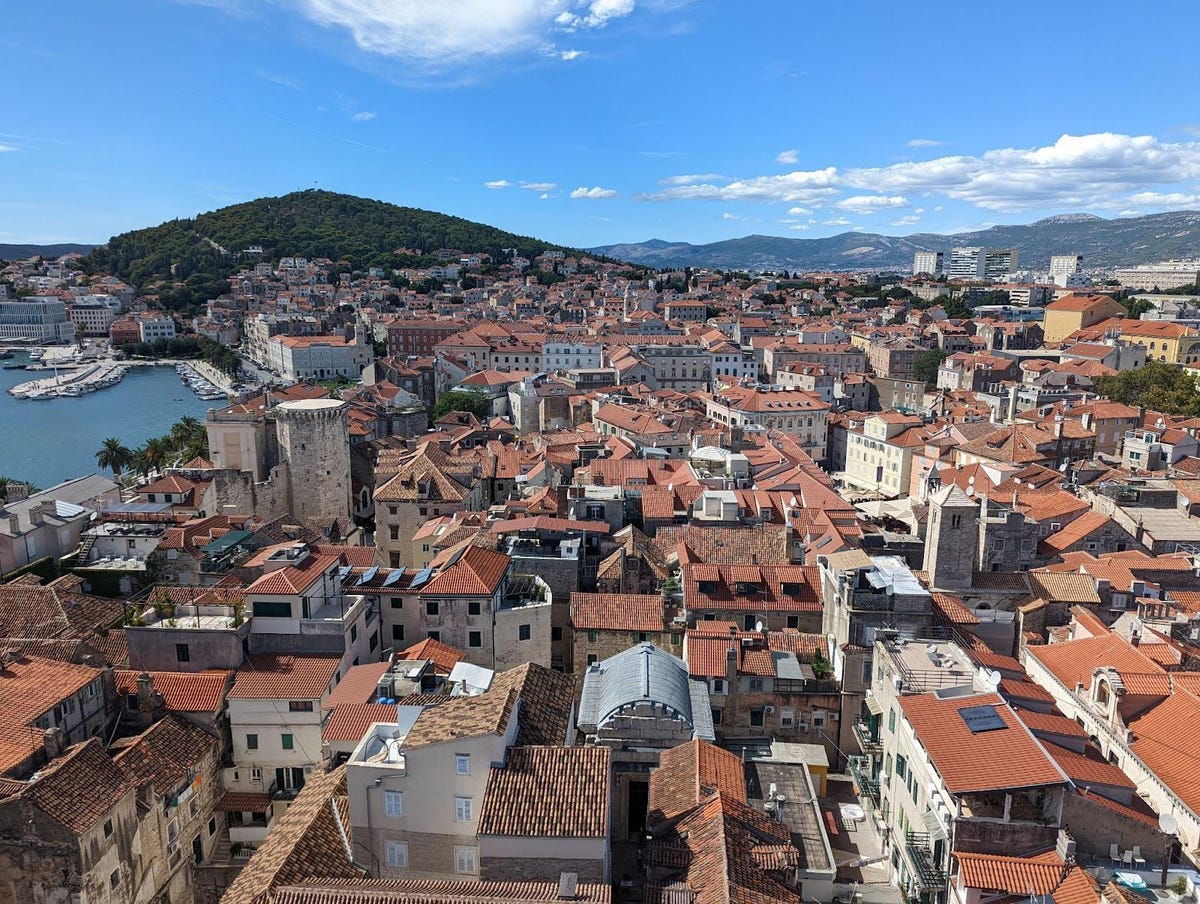[ad_1]
A view of Split, Croatia, from Saint Domnius Bell Tower. Croatia is one of the most popular European … [+]
There’s already a slight chill in the air in Split, Croatia, in early September. The scent of ripening figs and pine needles permeates the ancient city center. Residents seem relieved that the fall travel season has begun in Europe.
But this year, their relief may be short-lived.
“Travel to Europe this fall is booming,” says Mandy Pullin, a travel advisor with DPP Travel. “Suppliers and travel advisors are struggling to meet the intense need for people to get away. Adding to that urgency is the euro and the dollar being almost one-to-one, so travelers can more easily see the value of their dollars.”
Airfares and room rates are falling with the fig leaves in Split and elsewhere, but the dynamic has shifted. Demand for travel to Europe remains unseasonably high. And there are the wildcards, like inconsistent air service and COVID. All that may leave you wondering if it’s still worth visiting Europe this fall.
In Split, hope for a return to “normal”
Vjeran Mlačić, a tour guide in Split, says the city’s tourism officials are pleased to have visitors back after two slower pandemic years. But the tourists have kept coming, and there’s no sign of them stopping.
Split’s inner city, with its narrow streets and Roman ruins, is as crowded as ever. In some of the smaller passageways, bottlenecks can even make pedestrian traffic come to a complete standstill.
“When the flights to Split stop,” he says. “things go back to normal.”
But this year, the seasonal flights from European hubs will continue until October. Every year, says Mlačić, the dates move back farther. It’s something that’s happening all across Europe as interest in tourism remains at record levels.
“September is actually busier in Europe than August was for the first time in my 22-year career,” says Jack Ezon, managing partner at EMBARK Beyond.
Sales are up 34% in September and October is up 34% over 2019 and 37% over 2018 — a new record. Croatia and Montenegro are among the hottest destinations, with his customers flocking to resorts like the new One&Only Portonovi, “which is probably the best luxe value in the Med and amazing,” according to Ezon.
Fall prices to Europe are lower, but …
- Airfares from the United States to Europe are down 24% from this summer, an average savings of $182 per ticket, according to Hopper.
- Hotel occupancy for the region in September is at 54%, which is on par with 2019 performance but well ahead of 2021 (31%), according to travel technology company Amadeus. Expect some discounts in touristy areas, where rates may be as much s $136 per night lower in places like Mykonos, Greece.
- But short-term rental bookings in Europe for the rest of the year are pacing 7% higher than pre-pandemic levels and 36% higher than last year, according to Airdna. September and November are the two best-performing months, with a 10% growth in bookings compared to 2019. Compared to last year, October registers a 49% growth in bookings.
Demand is high for travel to Europe
Earlier this year, Allianz Partners famously predicted that travel to Europe would increase by 600% in 2022. By all accounts, that may have happened this summer — and it may also be true for the fall. There are no reliable predictions for autumn in Europe. The European Travel Commission hasn’t released a forecast for fall, leaving experts to speculate.
“While some are expecting travel volume to Europe to remain down compared to pre-pandemic levels, it will still likely be the busiest fall travel season since 2019,” says Narendra Khatri, principal of Insubuy, a travel insurance company. “Plus, with so many flights being canceled, it may seem like it’s busier than ever to the average traveler.”
But talking to people in Split, you get the idea that summer may never end. There’s no Labor Day in Croatia, but the streets are still packed with tourists this weekend. On a warm Friday afternoon, you can hear English, French and German spoken by visitors on the streets and in the café. August, the traditional vacation month, may be over — but these people apparently didn’t get the memo.
How to save money on a trip to Europe this fall
In Europe, prices can be deceptive. Croatia, for example, still uses the kuna as legal currency — it switches to the euro at the end of this year. But even with the dollar at parity with the euro, inflation in Europe has been running high. That means you may pay more for your hotel, restaurant meal and tour. Here’s my complete guide on planning a trip.
- If you want to save on accommodations, aim for late fall. That’s when everyone here expects a more significant drop-off in visitors. But aim carefully. If you get to Europe too soon, you’ll still face crowds and high prices. Get to Europe too late, and it’s too cold to really enjoy the outdoors. Depending on your destination, mid- to late-October is about as late as you’ll want to go.
- Restaurants don’t usually lower their rates during the off-season, but many visitors to Europe save money by booking a vacation rental and doing their own cooking. Or they venture out of town to find a restaurant outside the touristy areas at a more reasonable price. These are tried-and-true strategies that will work this fall.
- When it comes to transportation, one of the best secrets is mass transit. It is cheap and reliable in most European countries. So, unless you’re touring Alpine villages by car or driving up the coast of Norway, you’ll want to check bus and train options before renting a car.
But face it: Europe has never been a cheap travel destination. You’ll be able to save some money because of the favorable exchange rate, but you won’t be able to buy a castle.
Expert advice for your fall trip to Europe
Here’s some expert advice on how to plan a better trip:
Don’t wait to plan your fall trip to Europe
Plan in advance so you can ensure access to all of the sites on your list,” advises Sara Kramer, director of marketing at Ker & Downey. If you do, you may have more options, like special tours, private villas, river barges, and yachts. Those are filling up fast, even during the fall.
Yes, COVID is still an issue
That’s the assessment of Betsy Ball, cofounder of Euro Travel Coach. “COVID is still an issue because it’s still with us,” she says. But she says it’s much easier to travel to Europe than it has been in the last several years. Also, the U.S. doesn’t require a negative test to enter anymore, which makes your return trip easier.
Give yourself extra time on the ground
“Plan for two extra days before and after the main trip,” advises Marino Cardelli, CEO of Experience BellaVita. “I’ve had many clients whose flights were canceled or delayed. So having extra time before and after allows for a safer journey.” That’s always solid advice, but with this summer’s airline delays expected to continue indefinitely, it’s essential not to let down your guard. Your trip to Europe could get seriously disrupted this fall.
So should you visit Europe this fall?
With all that’s going on — high prices, continued airline chaos, COVID — should you still visit Europe this fall? Absolutely, say experts.
“Fall is probably the best time to visit Europe,” says Kat Kalashian, special projects manager for Live and Invest Overseas. “The weather is cool and pleasant, much like spring but without all the spring tourists. All locals are back to their routines and kids are in school, so museums and monuments are far less crowded overall.”
If you visit Europe, expect fall conditions, but treat it like summer. Prepare for airline delays, watch for COVID and keep an eye on your bottom line. COVID has turned everything on its head, including the predictable nature of fall travel to Europe. At least, that’s what they’ll tell you in Split.
[ad_2]
Source link





